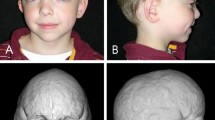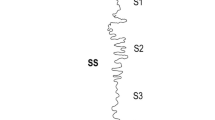Abstract
Objective
Several techniques to remodel the posterior calvarium in order to increase intracranial volume (ICV) and to improve cosmetic appearance are reported. This study presents the results of meander technique in patients with brachycephaly and posterior plagiocephaly.
Methods
During December 2011 and July 2013, a total of 12 children (median age: 15 months) underwent posterior cranial vault remodeling by the meander technique (brachycephaly, n = 6; posterior plagiocephaly, n = 6). The available pre- and postoperative MRIs were assessed with regard to ICV, cranial index (CI) and asymmetry index (AI) as well as the position of the cerebellar tonsils.
Results
No intra- or postoperative complications were observed. Blood transfusions were necessary in nine of 12 patients. A significant increase of the ICV from 1,178.4 ± 134.5 to 1,293.0 ± 137.5 cm3 (p < 0.05) is demonstrated. In the patients with brachycephaly the CI was significantly improved from 0.97 ± 0.12 to 0.89 ± 0.12 postoperatively (p < 0.05). The AI in patients with posterior plagiocephaly was significantly ameliorated from 0.83 ± 0.04 to 0.92 ± 0.02 postoperatively (p < 0.05). There was a significant effect on cerebellar tonsil position in relation to foramen magnum level for patients with brachycephaly (right tonsil: 11.9 ± 9.2 to 7.0 ± 9.1 mm, p < 0.05; left: 10.8 ± 9.5 to 9.7 ± 10.6 mm; p < 0.05) as well as in posterior plagiocephaly for the ipsilateral tonsil (3.2 ± 3.5 to 1.6 ± 3.5 mm; p < 0.01).
Conclusion
The presented surgical technique is considered to be safe. The technique is capable to significantly increase ICV and improve cosmetic appearance of the remodeled calvarium. Further evidence that posterior cranial vault remodeling influences the position of the cerebellar tonsils is added by the results of the study.



Similar content being viewed by others
References
Abbott AH, Netherway DJ, Niemann DB, Clark B, Yamamoto M, Cole J, Hanieh A, Moore MH, David DJ (2000) CT-determined intracranial volume for a normal population. J Craniofacial Surg 11(3):211–223
Argenta LC, David LR, Wilson JA, Bell WO (1996) An increase in infant cranial deformity with supine sleeping position. J Craniofacial Surg 7(1):5–11
Arnaud E, Marchac A, Jeblaoui Y, Renier D, Di Rocco F (2012) Spring-assisted posterior skull expansion without osteotomies. Childs Nerv Syst 28(9):1545–1549. doi:10.1007/s00381-012-1843-4
Brain Development Cooperative G (2012) Total and regional brain volumes in a population-based normative sample from 4 to 18 years: the NIH MRI Study of Normal Brain Development. Cereb Cortex 22(1):1–12. doi:10.1093/cercor/bhr018
Choi M, Flores RL, Havlik RJ (2012) Volumetric analysis of anterior versus posterior cranial vault expansion in patients with syndromic craniosynostosis. J Craniofacial Surg 23(2):455–458. doi:10.1097/SCS.0b013e318240ff49
Cinalli G, Chumas P, Arnaud E, Sainte-Rose C, Renier D (1998) Occipital remodeling and suboccipital decompression in severe craniosynostosis associated with tonsillar herniation. Neurosurgery 42(1):66–71, discussion 71–63
Cinalli G, Spennato P, Sainte-Rose C, Arnaud E, Aliberti F, Brunelle F, Cianciulli E, Renier D (2005) Chiari malformation in craniosynostosis. Childs Nerv Syst 21(10):889–901. doi:10.1007/s00381-004-1115-z
Davis C, MacFarlane MR, Wickremesekera A (2010) Occipital expansion without osteotomies in Apert syndrome. Childs Nerv Syst 26(11):1543–1548. doi:10.1007/s00381-010-1144-8
de Jong T, Rijken BF, Lequin MH, van Veelen ML, Mathijssen IM (2012) Brain and ventricular volume in patients with syndromic and complex craniosynostosis. Childs Nerv Syst 28(1):137–140. doi:10.1007/s00381-011-1614-7
Dekaban AS (1977) Tables of cranial and orbital measurements, cranial volume, and derived indexes in males and females from 7 days to 20 years of age. Ann Neurol 2(6):485–491. doi:10.1002/ana.410020607
Deschamps-Braly J, Hettinger P, el Amm C, Denny AD (2011) Volumetric analysis of cranial vault distraction for cephalocranial disproportion. Pediatr Neurosurg 47(6):396–405. doi:10.1159/000337873
Di Rocco F, Marchac A, Duracher C, Perie AC, Vergnaud E, Renier D, Arnaud E (2012) Posterior remodeling flap for posterior plagiocephaly. Childs Nerv Syst 28(9):1395–1397. doi:10.1007/s00381-012-1842-5
Engel M, Castrillon-Oberndorfer G, Hoffmann J, Orakcioglu B, Rohde S, Seeberger R, Freudlsperger C (2012) Chiari malformation in nonsyndromal single craniosynostosis—much ado about nothing? Acta Neurochirurg 154(10):1803–1807. doi:10.1007/s00701-012-1439-5
Goldstein JA, Paliga JT, Wink JD, Low DW, Bartlett SP, Taylor JA (2013) A craniometric analysis of posterior cranial vault distraction osteogenesis. Plastic Reconstr Surg 131(6):1367–1375. doi:10.1097/PRS.0b013e31828bd541
Goodrich JT, Tepper O, Staffenberg DA (2012) Craniosynostosis: posterior two-third cranial vault reconstruction using bioresorbable plates and a PDS suture lattice in sagittal and lambdoid synostosis. Childs Nerv Syst 28(9):1399–1406. doi:10.1007/s00381-012-1767-z
Graham JM Jr, Gomez M, Halberg A, Earl DL, Kreutzman JT, Cui J, Guo X (2005) Management of deformational plagiocephaly: repositioning versus orthotic therapy. J Pediatr 146(2):258–262. doi:10.1016/j.jpeds.2004.10.016
Karppinen A, Koljonen V, Valanne L, Leikola J (2012) Asymmetric laterality of Chiari type I malformation in patients with non-syndromic single-suture craniosynostosis. Acta Neurochirurg 154(11):2103–2107. doi:10.1007/s00701-012-1470-6
Leikola J, Hukki A, Karppinen A, Valanne L, Koljonen V (2012) The evolution of cerebellar tonsillar herniation after cranial vault remodeling surgery. Childs Nerv Syst 28(10):1767–1771. doi:10.1007/s00381-012-1816-7
Levitt MR, Niazi TN, Hopper RA, Ellenbogen RG, Ojemann JG (2012) Resolution of syndromic craniosynostosis-associated Chiari malformation Type I without suboccipital decompression after posterior cranial vault release. J Neurosurg Pediatr 9(2):111–115. doi:10.3171/2011.11.PEDS11268
Lichtenberg R (1960) Radiographie du crane de 226 enfants normaux de la naissance a 8 ans: Impressions digitiformes, capacite, angles et indices. Doctoral En Medecine thesis, University of Paris
Lipira AB, Gordon S, Darvann TA, Hermann NV, Van Pelt AE, Naidoo SD, Govier D, Kane AA (2010) Helmet versus active repositioning for plagiocephaly: a three-dimensional analysis. Pediatrics 126(4):e936–945. doi:10.1542/peds.2009-1249
Netherway DJ, Abbott AH, Anderson PJ, David DJ (2005) Intracranial volume in patients with nonsyndromal craniosynostosis. J Neurosurg 103(2 Suppl):137–141. doi:10.3171/ped.2005.103.2.0137
Nowinski D, Di Rocco F, Renier D, SainteRose C, Leikola J, Arnaud E (2012) Posterior cranial vault expansion in the treatment of craniosynostosis. Comparison of current techniques. Childs Nerv Syst 28(9):1537–1544. doi:10.1007/s00381-012-1809-6
Posnick JC, Armstrong D, Bite U (1995) Crouzon and Apert syndromes: intracranial volume measurements before and after cranio-orbital reshaping in childhood. Plastic Reconstr Surg 96(3):539–548
Posnick JC, Armstrong D, Bite U (1995) Metopic and sagittal synostosis: intracranial volume measurements prior to and after cranio-orbital reshaping in childhood. Plastic Reconstr Surg 96(2):299–309, discussion 310–295
Scott WW, Fearon JA, Swift DM, Sacco DJ (2013) Suboccipital decompression during posterior cranial vault remodeling for selected cases of Chiari malformations associated with craniosynostosis. J Neurosurg Pediatr 12(2):166–170. doi:10.3171/2013.4.PEDS12463
Sgouros S, Hockley AD, Goldin JH, Wake MJ, Natarajan K (1999) Intracranial volume change in craniosynostosis. J Neurosurg 91(4):617–625. doi:10.3171/jns.1999.91.4.0617
Steinbacher DM, Skirpan J, Puchala J, Bartlett SP (2011) Expansion of the posterior cranial vault using distraction osteogenesis. Plastic Reconstr Surg 127(2):792–801. doi:10.1097/PRS.0b013e318200ab83
Tuncbilek G, Alanay Y, Uzun H, Kayikcioglu A, Akarsu NA, Benli K (2010) Intracranial and extracranial malformations in patients with craniofacial anomalies. J Craniofacial Surg 21(5):1460–1464. doi:10.1097/SCS.0b013e3181ebcd27
Turk AE, McCarthy JG, Thorne CH, Wisoff JH (1996) The “back to sleep campaign” and deformational plagiocephaly: is there cause for concern? J Craniofacial Surg 7(1):12–18
Wagner W, Schwandt E, Huthmann A, Vulcu S, Tschan C (2010) Posterior calvarial augmentation in premature craniosynostosis: a technique avoiding foreign implants or free bone flaps. Childs Nerv Syst 26(11):1549–1553. doi:10.1007/s00381-010-1158-2
White N, Evans M, Dover MS, Noons P, Solanki G, Nishikawa H (2009) Posterior calvarial vault expansion using distraction osteogenesis. Childs Nerv Syst 25(2):231–236. doi:10.1007/s00381-008-0758-6
Author information
Authors and Affiliations
Corresponding author
Rights and permissions
About this article
Cite this article
Schulz, M., Spors, B., Haberl, H. et al. Results of posterior cranial vault remodeling for plagiocephaly and brachycephaly by the meander technique. Childs Nerv Syst 30, 1517–1526 (2014). https://doi.org/10.1007/s00381-014-2462-z
Received:
Accepted:
Published:
Issue Date:
DOI: https://doi.org/10.1007/s00381-014-2462-z




